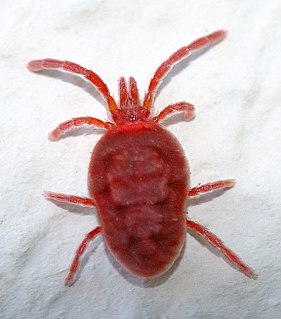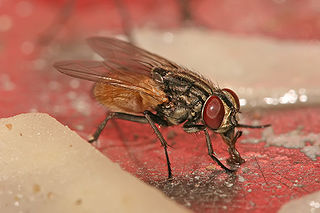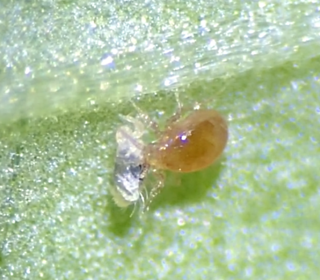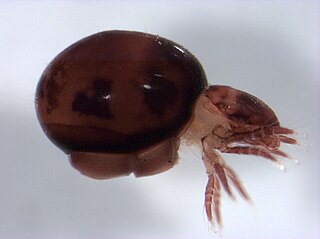
Drosophila is a genus of flies, belonging to the family Drosophilidae, whose members are often called "small fruit flies" or pomace flies, vinegar flies, or wine flies, a reference to the characteristic of many species to linger around overripe or rotting fruit. They should not be confused with the Tephritidae, a related family, which are also called fruit flies ; tephritids feed primarily on unripe or ripe fruit, with many species being regarded as destructive agricultural pests, especially the Mediterranean fruit fly.

Mites are small arachnids. Mites span two large orders of arachnids, the Acariformes and the Parasitiformes, which were historically grouped together in the subclass Acari, but genetic analysis does not show clear evidence of a close relationship.

Muscidae are a family of flies found in the superfamily Muscoidea.

Stomoxys is a genus of flies in the family Muscidae. The genus is unusual among the Muscidae in that it includes species that are bloodsucking ectoparasites of mammals. The best-known species is Stomoxys calcitrans, most commonly known as the stable fly.

The Phytoseiidae are a family of mites which feed on thrips and other mite species. They are often used as a biological control agent for managing mite pests. Because of their usefulness as biological control agents, interest in Phytoseiidae has steadily increased over the past century. Public awareness of the biological control potential of invertebrates has been growing, though mainly in the US and Europe. In 1950, there were 34 known species. Today, there are 2,731 documented species organized in 90 genera and three subfamilies.

Oribatida, also known as oribatid mites, moss mites or beetle mites, are an order of mites, in the "chewing Acariformes" clade Sarcoptiformes. They range in size from 0.2 to 1.4 millimetres. There are currently 12,000 species that have been identified, but researchers estimate that there may be anywhere from 60,000 to 120,000 total species. Oribatid mites are by far the most prevalent of all arthropods in forest soils, and are essential for breaking down organic detritus and distributing fungi.

Poecilochirus is a Holarctic genus of mites in the family Parasitidae. They are relatively large and often found on rotting corpses, where they are transported by beetles. Deuteronymphs are characterized by two orange dorsal shields and in many species a transverse band on the sternal shield. The juvenile development consists of a larval stage, protonymph, and deuteronymph, but no tritonymph. Females are smaller than males. Males guard female deuteronymphs shortly before these mate, and pairs mate venter-to-venter.

The housefly is a fly of the suborder Cyclorrhapha. It is believed to have evolved in the Cenozoic Era, possibly in the Middle East, and has spread all over the world as a commensal of humans. It is the most common fly species found in houses. Adults are gray to black, with four dark, longitudinal lines on the thorax, slightly hairy bodies, and a single pair of membranous wings. They have red eyes, set farther apart in the slightly larger female.

Pseudolynchia canariensis, the pigeon louse fly or pigeon fly, is a species of biting fly in the family of louse flies, Hippoboscidae.

Hydrachnidia, also known as "water mites", Hydrachnidiae, Hydracarina or Hydrachnellae, are among the most abundant and diverse groups of benthic arthropods, composed of 6,000 described species from 57 families. As water mites of Africa, Asia, and South America have not been well-studied, the numbers are likely to be far greater. Other taxa of parasitengone mites include species with semi-aquatic habits, but only the Hydracarina are properly subaquatic. Water mites follow the general Parasitengona life cycle: active larva, inactive (calyptostasic) protonymph, active deutonymph, inactive tritonymph and active adult. Usually, larvae are parasites, while deutonymphs and adults are predators.

Macrochelidae is a family of mites in the order Mesostigmata.
Macrocheles monticola is a species of mite in the family Macrochelidae.
Macrocheles penicilliger is a species of mite in the family Macrochelidae. It is found in New Zealand.
Macrocheles perglaber is a species of mite in the family Macrochelidae. It is found in New Zealand.
Macrocheles roquensis is a species of mite in the family Macrochelidae.

Phoresis or phoresy is a non-permanent, commensalistic interaction in which one organism attaches itself to another solely for the purpose of travel. Phoresis has been observed directly in ticks and mites since the 18th century, and indirectly in fossils 320 million years old. It is not restricted to arthropods or animals; plants with seeds that disperse by attaching themselves to animals are also considered to be phoretic.

Brevipalpus phoenicis, also known as the false spider mite, red and black flat mite, and in Australia as the passionvine mite, is a species of mite in the family Tenuipalpidae. This species occurs globally, and is a serious pest to such crops as citrus, tea, papaya, guava and coffee, and can heavily damage numerous other crops. They are unique in having haploid females, a condition caused by a bacterium that change haploid males into females.
Drosophila nigrospiracula is a fly species indigenous to the Sonoran Desert, spanning Arizona, California, and part of Sonora, Mexico. D. nigrospiracula share the Sonoran Desert with three other species of Drosophila: D. pachea, D. mettleri, and D. mojavensis. This fly breeds on the decomposing tissues of two species of cacti that are also endemic to the region: cardón (Pachycereus pringlei) and saguaro (Carnegiea gigantea).

Scaptomyza is a genus of vinegar flies, insects in the family Drosophilidae. As of 2022, there are 273 described species of Scaptomyza. Of those, 148 are endemic to the Hawaiian archipelago. This genus is part of the species-rich lineage of Hawaiian Drosophilidae, and is the sister lineage to the endemic Hawaiian Drosophila. The genus Scaptomyza is one of several nested within the paraphyletic genus Drosophila.
Drosophila metlerri, commonly known as the Sonoran Desert fly, is a fly in the genus Drosophila. The species is found in North America and is most concentrated along the southern coast of California and in Mexico. D. mettleri are dependent on plant hosts, namely, the saguaro and cardon cacti. Thus, they are most prevalent in arid, desert conditions. It is able to detoxify chemicals found in the rotting liquid of cacti hosts, which allows it to use otherwise lethal soil as a nesting site.













